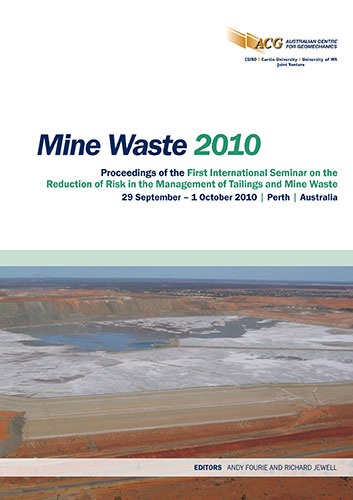Predicting void ratio for surface paste tailings deposition

|
Authors: Salfate, ER; Wilson, GW; Wijewickreme, D; Simms, P |
DOI https://doi.org/10.36487/ACG_rep/1008_39_Salfate
Cite As:
Salfate, ER, Wilson, GW, Wijewickreme, D & Simms, P 2010, 'Predicting void ratio for surface paste tailings deposition', in R Jewell & AB Fourie (eds), Mine Waste 2010: Proceedings of the First International Seminar on the Reduction of Risk in the Management of Tailings and Mine Waste, Australian Centre for Geomechanics, Perth, pp. 473-485, https://doi.org/10.36487/ACG_rep/1008_39_Salfate
Abstract:
Paste tailings have proven to be a reliable technology with advantages in terms of safety and water savings. Although safety is always the priority when designing this type of facilities, effective water usage has turned out to be of special importance for dry regions where the benefits of saving water often justify the use of this technology. Current design requirements have revealed the need to reliably predict the deposited and post- deposited void ratio and density of the paste. These properties are fundamental for determining the stability of paste impoundments, especially under undrained conditions. This paper presents an overview of the modelling framework under which some of the initial properties of paste tailings can be predicted. The approach is based on the application of unsaturated soil mechanics, through which drying and volume change of the paste can be related. The results using this framework seem to correlate well with those from drying tests performed in the laboratory, thus confirming the validity of the modelling approach. Several case scenarios were evaluated using this modelling framework. Variables such as paste layer thickness, drying time of the paste, and climate have been modified to observe their effect over water content and void ratio distribution. The results presented herein demonstrate how void ratio and density of the paste would change under different operational and climatic conditions. The long-term goal of the research is to develop a model that may be used as a planning tool during the design stages of paste tailings storage facilities.
References:
Bryan, R. (2008) Drying and Oxidation of Surface Disposed Paste Tailings, Master of Applied Science Thesis, Carleton
University, Ottawa, Ontario, Canada.
Dunmola, A. and Simms, P. (2010) Solute mass transport and atmospheric drying of high-density gold tailings, in
Proceedings Thirteenth International Seminar on Paste and Thickened Tailings (Paste2010), R.J. Jewell and A.B.
Fourie (eds), 3–6 May 2010, Toronto, Canada, Australian Centre for Geomechanics, Perth, pp. 279–289.
Fisseha, B., Bryan, R. and Simms, P. (2010). Evaporation, unsaturated flow and salt accumulation in multilayer deposits
of a ‘paste’ tailings, ASCE Journal of Geotechnical and Geoenvironmental Engineering, In Press.
Fredlund, D. and Xing, A. (1994) Equations for the Soil Water Characteristic Curve, Canadian Geotechnical Journal,
Vol. 31, pp. 521–532.
Fredlund, M.D. (1999) The Role of Unsaturated Soil Properties Functions in the Practice of Unsaturated Soil
Mechanics, PhD Thesis, University of Saskatchewan, Saskatoon, Canada.
Simms, P. Dunmola, A. and Fisseha, B. (2009b) Generic predictions of drying time in surface deposited thickened
tailings in a ‘wet’ climate, in Proceedings of Tailings and Mine Waste 2009, University of Alberta, Banff,
Alberta, November 1–4 2009, pp. 749–758.
Simms, P., Dunmola, A., Fisseha, B. and Bryan, R. (2010) Generic modelling of desiccation for cyclic deposition of
thickened tailings to maximize density and to minimize oxidation, in Proceedings Thirteenth International
Seminar on Paste and Thickened Tailings (Paste2010), R. Jewell and A.B. Fourie (eds), 3–6 May 2010, Toronto,
Canada, Australian Centre for Geomechanics, Perth, pp. 293–301.
Simms, P., Fisseha, B. and Bryan, R. (2009a) Evaporation, Unsaturated Flow, and Salt Accumulation in Multilayer
Deposits of a Paste Gold Tailings, in Proceedings Twelfth International Seminar on Paste and Thickened
Tailings (Paste09), R. Jewell, A.B. Fourie, S. Barrera, J. Wiertz (eds), 21–24 April 2009, Viña Del Mar, Chile,
Gecamin Limited, Santiago, pp. 251–260.
Simms, P., Grabinsky, M.W. and Zhan, G. (2007) Modelling Evaporation of Paste Tailings from the Bulyanhulu Mine,
Canadian Geotechnical Journal, Vol. 44, pp. 1417–1432.
Wilson, G.W. (1990) Soil Evaporative Fluxes for Geotechnical Engineering Problems, Ph.D Thesis, University of
Saskatchewan, Saskatoon, Canada.
Wilson, G.W., Fredlund, D.G. and Barbour, S.L. (1994) Coupled Soil-Atmosphere Modelling for Soil Evaporation,
Canadian Geotechnical Journal, Vol. 31(2), pp. 151–161.
Predicting void ratio for surface paste tailings deposition E.R. Salfate et al.
486 Mine Waste 2010, Perth, Australia
© Copyright 2025, Australian Centre for Geomechanics (ACG), The University of Western Australia. All rights reserved.
View copyright/legal information
Please direct any queries or error reports to repository-acg@uwa.edu.au
View copyright/legal information
Please direct any queries or error reports to repository-acg@uwa.edu.au